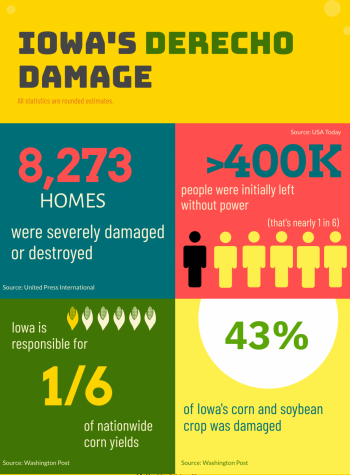Nearly 8,300 homes were damaged in a matter of minutes. A gloomy Monday morning in Iowa turned into a disastrous storm with wind speeds reaching 140 mph, equivalent to a major hurricane. This storm was classified as a derecho, devastating 43% of corn and soybean crops and leaving upwards of $82.7 million in property damage.
The effects of the Aug. 10 derecho reached a large number of Iowans, including many in the West High community. Grace Paxton ’22 and her family lost power for four days, with plenty of others being in similar boats.
“The first night we had tried to find a hotel so we could use power, but all of them were either also without power or full,” Paxton said.
Like Paxton, over 400,000 were initially left powerless and around 30,000 are still without it, as of Aug. 20. Although Paxton’s family lost just a few roof shingles in terms of property damage, they noticed many knocked-down street signs and uprooted trees. Governor Kim Reynolds estimated that 8,273 homes were destroyed or experienced major damage, and Alliant Energy identified over 2,500 destroyed utility poles, according to United Press International.
The Cedar Rapids (CRCSD) and Linn-Mar Community School Districts have both delayed their school start dates, with every building in the CRCSD being damaged. Recognizing the unfortunate effects of the derecho, many communities in the state have come together in cleanup efforts, food donations and other disaster relief initiatives.
“Almost immediately after the storm ended, many of my neighbors gathered to clean up the street and yards that were covered in sticks as well as larger branches, including two neighbors using chainsaws to remove what looked like it could’ve been a small tree,” Paxton said.
Furthermore, grocery stores and churches are among those engaged in food distribution, and Operation BBQ in Cedar Rapids has been serving around 1,000 hot meals daily.

On the federal level, President Trump signed the disaster declaration requested by Gov. Reynolds on Monday and visited Cedar Rapids on Tuesday to survey the damage. The governor called for nearly $4 billion in federal aid, writing, “Resilience is in our DNA, but we’re going to need a strong and timely federal response to support recovery efforts.”
Much of the federal aid will go towards helping the agriculture industry which has suffered the most significantly. According to The Washington Post, around 43% or 10 million acres of Iowa’s corn and soybean crop has suffered damage from the derecho, leaving a $10 billion dent in the industry that is crucial to the state’s economy.
Iowa has been the country’s top corn producer for 26 years, with 2.58 billion bushels harvested last year, accounting for about one-sixth of nationwide yields.
Beginning in 2013, however, the agricultural industry has been hit repeatedly. This year’s trade disputes, ethanol industry decline, low demand and global pandemic all contribute to the lowest corn prices in over a decade.
The agricultural community is still recovering from the economic challenges caused by COVID-19, and the derecho represents yet another setback.
“These farmers put significant resources into this crop and were planning for strong yields. Now their crops have been damaged—some destroyed—and the state has lost tens of millions of bushels of grain storage just a few weeks before harvest begins,” said Iowa Secretary of Agriculture Mike Naig.
Not only will farmers struggle with production and sales, but they also may lack sufficient storage for their crops. According to the Iowa Department of Agriculture and Land Stewardship, the derecho seriously damaged or destroyed more than 57 million bushels of commercial grain storage capacity.
Iowans have been blown away by the effects of the derecho.
“In the short term, many of our farmers and businesses still need help cleaning up from the storm. Some are without power and need generators to turn on their lights, run their equipment and feed their livestock,” Naig said. “Looking down the road, we’ll also need support from our neighbors, crop insurance companies and federal disaster aid.”
To support farmers in the future, Iowans can make an effort to purchase Iowa-grown produce that they still have available.
For Paxton, the storm’s magnitude came as a surprise and the road to recovery seems indeterminate.
“I honestly thought this would be a normal thunderstorm, but the winds picked up so fast,” Paxton said. “I am scared to think about how long it will take for eastern Iowa to fully recover.”
This story was originally published on West Side Story on August 22, 2020.































![IN THE SPOTLIGHT: Junior Zalie Mann performs “I Love to Cry at Weddings,” an ensemble piece from the fall musical Sweet Charity, to prospective students during the Fine Arts Showcase on Wednesday, Nov. 8. The showcase is a compilation of performances and demonstrations from each fine arts strand offered at McCallum. This show is put on so that prospective students can see if they are interested in joining an academy or major.
Sweet Charity originally ran the weekends of Sept. 28 and Oct. 8, but made a comeback for the Fine Arts Showcase.
“[Being at the front in the spotlight] is my favorite part of the whole dance, so I was super happy to be on stage performing and smiling at the audience,” Mann said.
Mann performed in both the musical theatre performance and dance excerpt “Ethereal,” a contemporary piece choreographed by the new dance director Terrance Carson, in the showcase. With also being a dance ambassador, Mann got to talk about what MAC dance is, her experience and answer any questions the aspiring arts majors and their parents may have.
Caption by Maya Tackett.](https://bestofsno.com/wp-content/uploads/2024/02/53321803427_47cd17fe70_o-1-1200x800.jpg)
![SPREADING THE JOY: Sophomore Chim Becker poses with sophomores Cozbi Sims and Lou Davidson while manning a table at the Hispanic Heritage treat day during lunch of Sept 28. Becker is a part of the students of color alliance, who put together the activity to raise money for their club.
“It [the stand] was really fun because McCallum has a lot of latino kids,” Becker said. “And I think it was nice that I could share the stuff that I usually just have at home with people who have never tried it before.”
Becker recognizes the importance of celebrating Hispanic heritage at Mac.
“I think its important to celebrate,” Becker said. “Because our culture is awesome and super cool, and everybody should be able to learn about other cultures of the world.”
Caption by JoJo Barnard.](https://bestofsno.com/wp-content/uploads/2024/01/53221601352_4127a81c41_o-1200x675.jpg)






